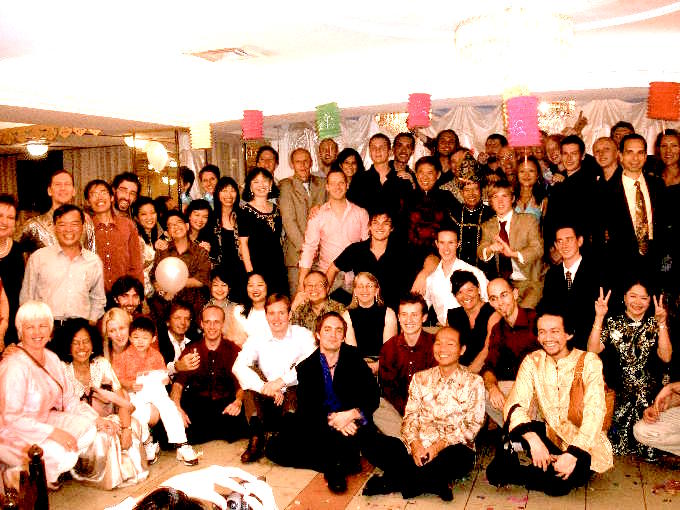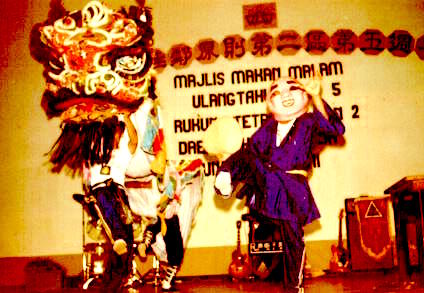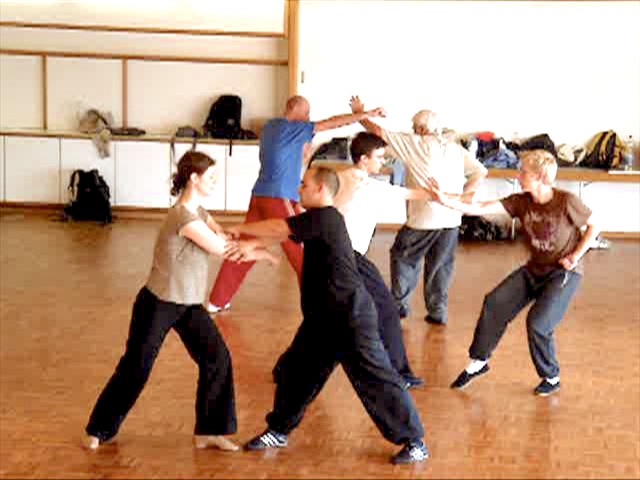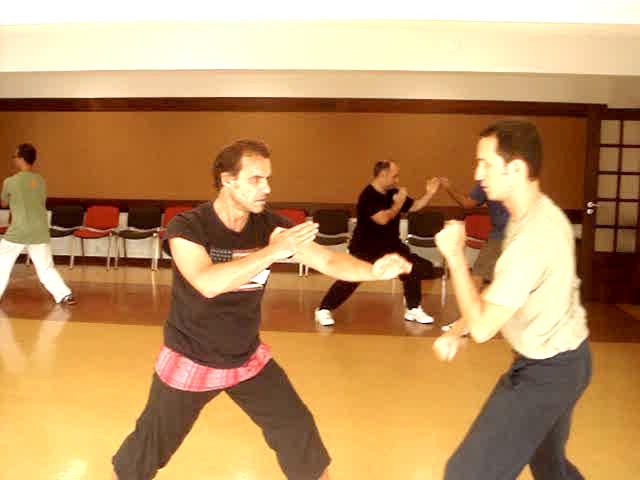February 2007 (Part 2)
SELECTION OF QUESTIONS AND ANSWERS

Members of the Shaolin Wahnam Family from all over the world gather in Sungai Petani, Malaysia to celebrate Wei Foong's wedding

To All Shaolin Wahnam Family Members and Friends
Question 1
Firstly I would like to thank you for the opportunity to attend Wei Foong and Peter"s wedding. We had a wonderful time and some great training and met a lot more of the Shaolin Wahnam family. A very memorable time.
— Kelie, Australia
Answer
It was great to have so many of our family members from all over the world gather together during Wei Foong and Peter's wedding. Simu and me appreciate very much the time and effort taken by all to attend the wedding celebrations.
Question 2
My training is going well. I can hold “Golden Bridge” for 30 min comfortably now and my sequences are becoming more flowing and I feel the benifits of internal force that you have mentioned.
Answer
Congratulations for your progress. Holding “Golden Bridge” comfortably for 30 minutes is a remarkable achievement. The internal force you have developed, among other benefits, may enable you to take punches and kicks (from ordinary persons) without you sustaining injuries. You may like to test this if you like, but you must proceed gently and carefully.
Ask a friend who has no internal force to punch you gently at first. Then ask him to gradually increase his punching power. You may be surprised that you don't feel any pain. But this does not necessarily meant that you are now invincible to punches and kicks.
This asking your friend to punch you is more for fun. A powerful punch or kick, especially from one with internal force, may still hurt you. But more significantly, your training has given you good health, vitality and mental freshness.
Question 3
Recently while in standing meditation my arms raised above my head with my palms facing upwards, my head pulled right back with my mouth open I felt pressure around the middle of my forehead while my whole body shook and trembled.
There was no pain and I felt myself expand way beyond my physical body. But I have read that you have said to keep your head level while in meditation to avoid chi going to your brain, so should I let my head lay right back or would it be better to keep it level?
Answer
The spontaneous pattern you adopted in your standing meditation is called “Embracing the Sun”. Some practitioners use this pattern to tap energy from the Cosmos.
In your case, this pattern which your chi flow spontaneously structured you into, enabled you to open your heart and liberate your spirit. Yours was a wonderful experience and attainment. Congratulations. The pressure on your forehead was an indication that your chi might be working to open your third eye.
The shaking and trembling of your body was due to the tremendous amount of internal force you had generated. Your expansion beyond your physical body was a satori, a spiritual awakening. You directly experienced what great masters in the past had said, that we are spirit and our physical body is actually an illusion.
This does not mean that we imagine our physical body to be there when it is not there. Given our normal conditions, our physical body is real. But when conditions change, like when you were in a heightened state of consciousness in that experience, you perceive reality differently and you may find your physical body not there because at that heightened level there is no physical body, only energy. Many of our Shaolin Wahnam family members have such wonderful experiences during their kungfu or chi kung sessions.
But don't cling on to this experience, no matter how spiritually beautifull and meaningful it is. If it occurs again, that is wonderful; if not, that is fine too. Just carry on with your daily practice, and enjoy it.
Obviously, you need not worry about your head level in such a situation. There is no worry about chi going into your brain and be locked up there. Your chi is radiating outward and your spirit expanding beyond your physical body. On the contrary, if during such an experience a practitioner forcefully brings his head back, or tense his head or intellectualize intensely, he might lock up chi in his brain.
My advice on the head level is meant for ordianry practitioners. You have far surpassed the ordinary. Although experiencing satoris is not uncommon in our school, it is actually a rare and advanced attainment. Even monks in a monastery would be very happy if they could have a satori after cultivating daily for a few years.
Keep me informed of your progress.

Participants at the regional Shaolin Kungfu course in Switzerland, including the woman on the left who is a fresh beginner, can use kungfu techniques for sparring.
Question 4
Sifu is always encouraging and gives us an “A” even when it is more like a “C”. Please tell us, Sifu, your vision for an “A”.
— Dr Damian, Malaysia
Answer
At the end of a course I often give an informal evaluation test. I often tell them the following.
Congratulations, everybody gets an “A”. This is an evaluation based on de-facto conditions. Today chi kung has been so debased that more than 80% of people who practice chi kung, or what they think is chi kung, cannot generate an energy flow even after many years of dedicated training.
Energy flow is essential in chi kung. Without chi flow, it is no longer chi kung; it degenerates into some sort of gentle physical exercise. It misses the wonderful benefits that chi kung can give.
In your session just now, everybody could generate an energy flow. This puts you at the top 20% of chi kung practitioners of the whole world. And you achieve this in just three days. If you can be at the top 20% category within such a short time, you certainly deserve an “A”.
On the other hand, if I compare your attainment now with your potential attainment if you continue to practice, I would only give you a “C”. This is actually a good sign. It means that even if you do not learn anything more from me, you still have a lot of good benefits to come.
The same philosophy applies in Shaolin Kungfu and Wahnam Taijiqjuan courses. All students will get an “A” based on de-facto conditions. More than 80% of those who practice Shaolin Kungfu or Taijiquan have no experience of internal force, and cannot apply their techniques in combat. Force development and combat application are the twin pillars in kungfu training.
By the end of the course all students are able to develop internal force and to use their kungfu techniques for combat. This would place them at the top 20% of kungfu practitioners in the world. Hence they deserve an “A”. But compared to their potential attainment if they continue practicing on their own, they just get a “C”.
Question 5
I have been practicing and trying to comprehend Taijiquan as best as I can from books. Some books that I am reading are “T'ai Chi, the Supreme Ultimate Exercise for Health, Sport, and Self-Defense", by Cheng Man-Ch'ing and Robert W. Smith, “Taijiquan Theory” by Dr. Yang, Jwing-Ming, Yang Chengfu's “The Essence and Applicaitons of Taijiquan”, and “Qigong for Health and Martial Arts” by Dr. Yang, Jwing-Ming.
— Jeffrey, USA
Answer
These are very good books by well known masters. It is wise of you to choose these books.
On the other hands there are also books written by people who may not know much or deeply about Taijiquan. Sometimes, some of these writers wrote as if they were masters, translating techniques from classical texts.
As they themselves have not practiced the techniques and experienced the results themselves, they do not know the subtle skills involved. Readers following their advice would not get any good results. Worse, they may have serious side-effects.
Question 6
Over the past 1 month of 20-30 minutes of practice per day on Taiji solo forms, and 30 minutes - 1 hr of meditation per day, the following observations have been made.
During the first week of small circulation meditation, I felt tingling around my stomach muscles. After 2 weeks, chi began to accumulate on my scalp, felt as tingling. During the 3rd week, chi suddenly rose from my dan tian, up my back, across the top of my head, and to my forehead where it stayed for quite some time in my meditative state.
During the 4th week, I felt a rush of chi to my hands and forearms. During the 5th week and to the present, I have been able to achieve a completely relaxed state in which the flow of chi is stronger.
Answer
Considering that you learn from books and practice on your own, you have done very well. Your results described above are those who have practiced correctly, but not necessarily in the best manner.
You lack the knowledge and ability in three areas which internal art practitioners should know, but many don't, namely
- Control of the chi flow
- Know the symptoms of wrong practice
- Remedial exercise to overcome deviations

Combat application is an important part of Taijiquan. Course participants in a regional Taijiquan class in Portugal enjoying Taijiquan combat
Question 7
While performing the Taiji form for the first week, I experienced accumulation of chi in my fingertips felt as tingling. A week later, I observed tingling sensations in the middle of my palm and fingers. 3 weeks later, I observed tingling sensations over my entire palm, and I perceived the raising of the spirit to the top of my scalp.
During the 4th week, I began to have a stronger flow to my hands when I perform the solo exercise. During the 5th week and at present, I now feel chi accumulation at a point on my spine between my shoulder blades along with the accumulation in my hands.
Answer
You have practiced your Taiji forms well as an internal art, and not just as a gentle physical exercise, as revealed in your various chi sensations. What you felt were healthy signs. If you continue your practice like this, you can have good health and vitality.
But Taijiquan is not just an internal art, it is also martial. In other words, your practice as it is can give you good health and vitality, but does not enable you to defend yourself. If you are not interested in the martial aspects of Taijiquan, that is fine. Indeed, most people today practice Taijiquan for health, and you are doing better than most people because they usually practice it as a gentle physical exercise whereas you are practicing it as an internal art.
If you wish to benefit from the martial aspects of Taijiquan, you have to learn from a competent teacher. You must learn from one who teaches Taijiquan as an internal martial art, which actually is rare today. If you find a teacher who teaches Taijiquan forms but uses Kick-Boxing for sparring, you would probably hurt yourself from sustaining injuries from sparring. You should learn from one who uses Taijiquan for sparring where injuries are minimal or nil.
Question 8
I do not feel like I have control of my chi when I meditate. It seems to go wherever it wants to go. I have the sensation of chi at various points on the governing vessel, however I do not feel the flow between all the points, and virtually no sensations on my conception vessel.
I hadn't thought much of it until I read some of your Q&A from people who have had blockages or over-accumulation of chi when performing strong qigong exercises. From doing my Taiji solo forms, I feel an invisible thin coating on my palms, which is one of the sensations I am worried about. Sometimes when I sit, I feel chi accumulate at the top of my scalp for no apparent reason, as if I am doing my solo form. This has worried me a little as well.
Answer
From you description you have been practicing correctly and very well. Many people have practiced Taijiquan for years but never have any chi sensations at all. Some Taijiquan masters, including well known ones, even say that chi does not exist! Strictly speaking, they have not practiced Taijiquan, they have only practiced Taiji external forms.
Don't worry if you do not feel chi between the energy points or at your conceptual vessel. You have practiced for less than two months, which is a short time.
When you do not feel chi flowing between energy points, or you feel chi only at the governing vessel but not at the conceptual vessel, this does not mean your chi is blocked. It may mean that your chi flow is not vigorous enough to flow through the points or vessels, which is not a deviation and there is nothing to be worried about.
As you continue your practice, your chi flow will be stronger and then it may flow through the points and vessels. But don't hurry, or crave for such result. Just continue you practice as usual, and enjoy it. When the time comes, the break-through will occur naturally.
The thin coating on your palm is chi. It shows you have been practicing correctly. It also suggests that the chi you feel at various energy points but not between them, is actually flowing though you may not be aware of the flow because it is not very strong.
Although you need not worry about it now, you should be careful about chi flow that you have no control. A very good technique you can add to your training is to gently think of your dan tian (located about two or three inches below your navel) when you complete your exercise. The instruction is “gently think of your dan tian”. Just do that. Don't add anything to it. Do not, for example, try to feel something at your dan tian when you think of it.
Letting chi flow wherever it goes is not harmful by itself. In fact, this is a desirable part of chi kung, and is called “free flow”. In classical texts, it was referred to as “wu-wei”, or spontaneity. It is this aspect of spontaneous chi flow without the conscious interference of the practitioner that enables him to overcome health problems that he himself may be unaware of, or overcome diseases which are considered “incurable” by modern Western medicine.
But enjoying spontaneous chi flow does not mean that the practitioner has no control of his chi flow. It means he voluntarily lets go of the control so that his chi can flow freely.
On the other hand, if you have not learnt the skills in controlling chi flow, it does not mean you cannot enjoy spontaneously chi flow and its benefits. But you have to be careful. Your chi flow should not be too strong or vigorous. If it gets too strong or vigorous, gently and gradually stop your practice.
But the most important is that you must not intellectualize or think of anything during your chi flow. Some people may wonder why this is so important. One main reason is that if the chi if flowing in your head, by intellectualizing you may lock up your chi there. If you know the remedial exercise, you can flush out the locked chi. But if you don't, having locked chi in your head can be problematic.
It does not mean that if your chi flow becomes strong or when you intellectualize, you will surely have problems, just as it does not mean that if somebody dashes across a street without looking, he will surely be knocked over by traffic. But the risks are there.
I would recommend that you stop practicing meditation and “small circulation” on your own. These are advanced exercises which should be attempted with the supervision of a competent teacher. At present you have been practicing correctly, but the risks of you making mistakes in future are real, and the side-effects can be serious.
It is only logical that if you practice on your own without the guidance of a good teacher, your progress cannot be very far. Actually your result so far is already remarkable considering that you practice from books. If you are satisfied with what you are getting now, you can carry on on your own.
But if you wish to progress further and also safely, you should learn from a good teacher.
To give you an idea for comparison, most students who learn from any of our certified Shaolin Wahnam instructors experience similar chi sensations in their first lesson! And they practice for only about 15 minutes per session, instead of an hour.
Within a month, they would have acquired the three pre-requisites for internal art training, i.e. skills to control chi flow, knowing symptoms of wrong practice, and ability to perform remedial exercise to overcome deviation if any.
Those who attend any of my intensive courses will get all these benefits and more during the courses themselves.
LINKS
Selected Reading
- The Secret of the Internal Force Masters
- Simply Delicious
- Learning the Twelve Taijiquan Combat Sequences
- Two Big Secrets in Single Tiger Emerges from Cave
- Free Sparring using Kungfu Patterns after just 3 Days of Training
